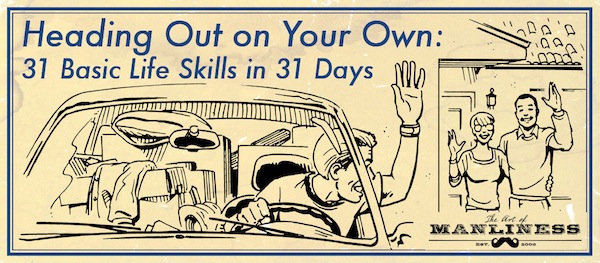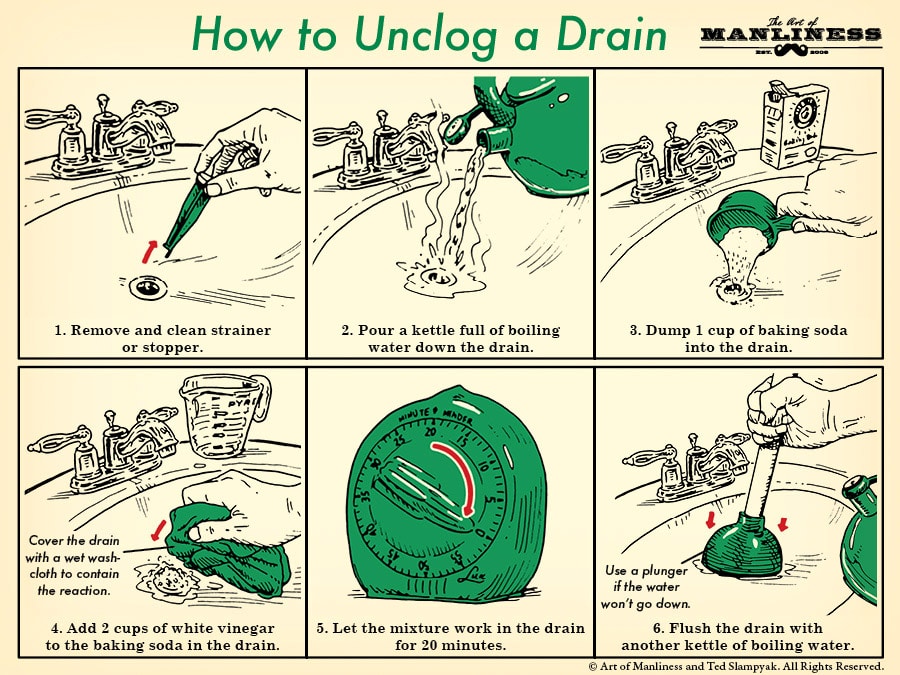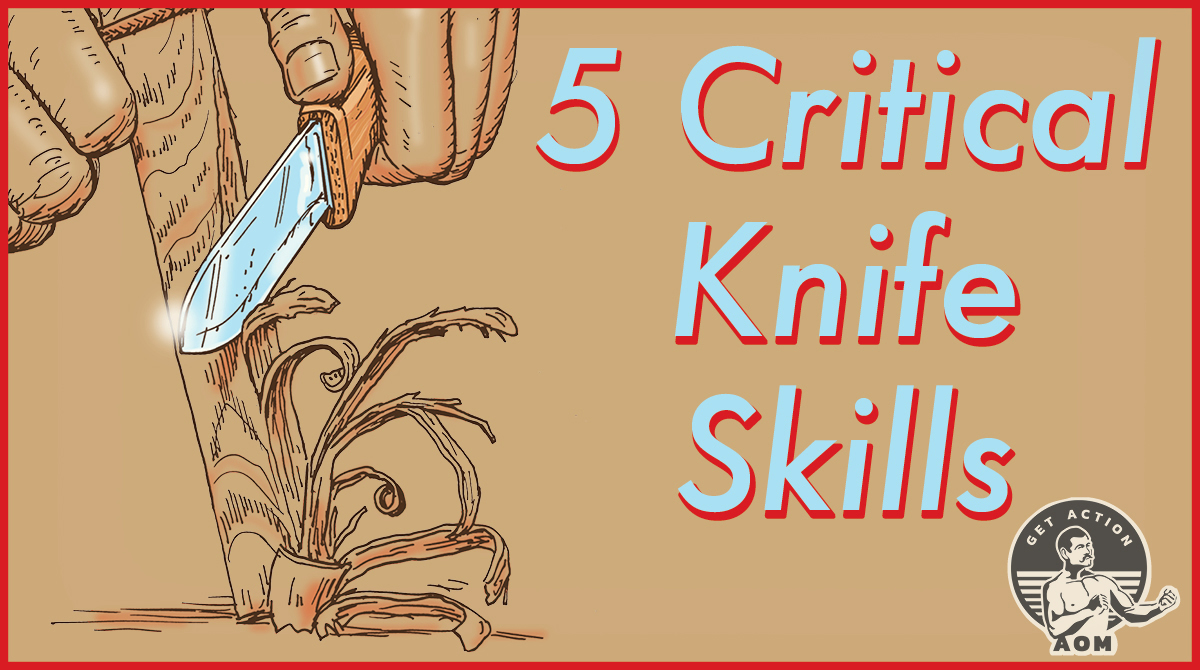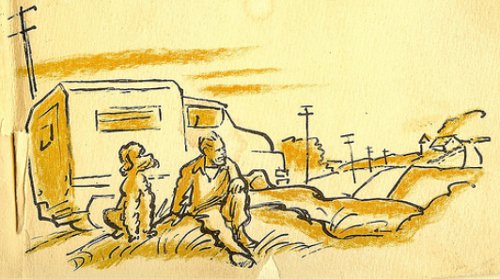
This article series is now available as a professionally formatted, distraction free paperback or ebook to read offline at your leisure.
Editor’s Note: This was originally published April 12, 2012. This is an updated version.
One of the first things many young men will be confronted with doing for themselves for the first time when they leave home is their laundry. It’s not exactly rocket science , but there is a surprising amount to it — believe it or not, whole books have been written on the subject! Today we’ll cover the essential basics in an easy-to-follow question and answer format. It’s an important skill to learn not just because everybody has to do it every single week without fail, but when you know how to do it properly, you won’t ruin your clothes or wear them out too quickly — something a young man on a budget can ill-afford to do. So let’s get started.
Contents [hide]
Before You Wash Your Clothes
How Often Do I Need to Wash Things?
You don't have to wash everything you own after only one use. The less you wash your clothes, the longer they'll last. While a lot depends on how often you shower/how smelly/sweaty you are/how long you wear the garment/the weather, and you can generally gauge whether something needs washing by how it feels and smells, here's a breakdown of how often on average to wash what:
- Undershirts/underwear/socks -- 1 wear. So have plenty of pairs. Don't turn your underwear inside-out for another use! But if you run out, and don't have time for a wash, wash a pair in the sink at night and let it dry for the morning.
- T-shirts -- 1 wear. They absorb a lot of oil and sweat.
- Jeans -- every 4-6 wears. Yes, it is possible to go many months without washing your denim (a must if it's selvedge denim), and if they don't smell, go right ahead; they won't accumulate any more bacteria after 300 wears than 15. You can spot-clean any stains you get (this goes for other clothing too).
- Khaki/cargo shorts and pants -- every 2-4 wears. Khakis don't hide dirt as well as jeans and absorb more bodily sweat and oil.
- Button-down shirts and sweaters -- 1-3 wears. Very dependent on how tightly the garment fits to the body, the weather, and how long you wore it. When you take it off, give the armpits a sniff. If they don't smell, put the shirt back on the hanger or drape the sweater over a chair to air out. If it's right on the border, try a shot of Febreeze.
- Pajamas -- 2-3 wears. Depending on how much you sweat at night (although everybody sweats more while sleeping than they realize -- around a liter a night)
- Towels -- once a week (given daily use).
- Bed sheets -- every two weeks. Experts say to wash bed sheets every week ideally, but I know most young men aren't going to do that. But at least wash them every couple of weeks (if you can't even manage that, at least wash your pillowcase--especially if you have acne-prone skin). If you need motivation, think of lying around in skin cells, dust mites and their feces, fungal mold and spores, bodily secretions, and bacteria. Not to mention insect parts, pollen, and soil. Sweet dreams.
How Do I Know How to Wash Something?
READ THE LABEL. If you get anything from this post, let it be this. Read the darn label. It will tell you exactly how to wash, dry, and iron your clothes. Don't worry. You don't need to know the meaning of those crazy laundry symbols you may have seen on your dad's 1980s polo shirt. Clothing manufacturers used to rely on them to tell consumers how to wash a piece of clothing. Today most clothing companies forego the symbols and literally spell out how you're supposed to wash their clothes. For example, my polo shirt from Criquet Shirts has the following washing instructions: "Machine wash cold. Wash with like colors. Non-chlorine bleach only. Tumble dry low. Warm iron as needed." I checked my other shirts, and all the labels were similiar: instructions all spelled out; no symbols.
If a piece of clothing says "Dry Clean Only," then take it to the cleaners. Yes, there are ways you can launder dry clean-only fabrics at home, but for a beginner it's not worth the risk, and for a young man, probably not worth the hassle. (If you're a low-maintenance guy who's never going to want to get something dry-cleaned, be sure to check the label before you buy something.)
How Do I Sort My Clothing Into Loads?
There are all kinds of elaborate laundry sorting systems out there, but for most young, college-aged men they're overkill. Here's the system I used during my bachelor years.
First, sort your dirty laundry by color. Many experts recommend creating three different color piles: whites, lights, and darks. In my experience, you just need two: whites and colors. Sorting by color ensures that your white dress shirts don't turn pink from the bleeding crimson from your OU Sooners t-shirt (don't ask).
After sorting by color, sort each pile by fabric heft: lighter fabrics (like dress shirts) in one pile and heavier fabrics (like jeans and sweatshirts) in another pile. I also create a pile that consists of bed linens and towels. Sorting by fabric type becomes important when we dry our laundry. Lighter items, like your t-shirts, dry much more quickly than your heavier items, like towels. When you dry light fabrics with other light fabrics, you can reduce the amount of time the dry cycle takes, which saves you money. This doesn't necessarily mean you'll need to do more loads either; heavier items, like jeans and sweatshirts, don't need to be washed as often as other stuff, so just "save up" until you have one big heavy item load to do.
What Do I Do About Stains?
While the nitty-gritty of stain removal is not within the purview of this post, many stains will come out in the wash if you simply pre-treat them with something like Shout. So when you sort through your clothes, be on the lookout for stains.
If you have white dress shirts or light-colored t-shirts in your dirty laundry, make sure to pre-treat your collar and your armpits with stain remover. You don't want that dreaded ring around your collar or yellow armpit stains. If you do get yellow armpit stains, here's how to get rid of them.
Washing Your Clothes
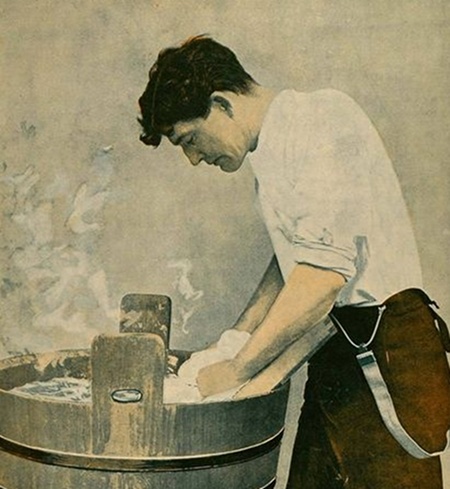
What Water Temperature Should I Use?
This can get confusing, but keep it simple: Use warm water for whites; cold water for colors. Now admittedly I used to be a hot water for whites guy, but after researching the heck out of this article, I found that most experts agree that with the efficiency of washers and detergents these days, using only warm, or even cold water for all washes is a-okay. You might still want to wash your linens, towels, and gym clothes (regardless of their color) in hot water though, since hot water is best at getting out the grime. But always cold for colors, as it fades the color of clothes less than hot water does.
What Cycle Should I Choose?
Your default cycle should be "regular." It's the longest cycle and has the fastest and most vigorous wash and spin cycles (spin cycles are when the machine spins out the water from the clothes). It's good for all fabric types.
Unless you have the same underclothing tastes as J. Edgar Hoover, you won't use the delicate cycle very often, except for things like sweaters or a nice dress shirt. Remember: read the label.
What about the ever mysterious permanent press cycle? This cycle is for synthetic fabrics like rayon, polyester, and acetate as well as natural fabrics that have been treated with a chemical to resist wrinkles (like your "no-iron" dress shirts). The permanent press cycle has a fast wash cycle and a slow spin cycle. The slow spin cycle keeps some of the water in the clothes, which helps prevent wrinkling. The only clothing I can imagine a young man having in his wardrobe that would require permanent press would maybe be a rayon vintage bowling shirt. Other than that, I think you're safe to use the regular cycle for most of your washing needs.
What Load Size Should I Choose?
Sometimes you have a crap load of clothes to clean, and other times you may have just a few items. Different amounts of water are required for each situation. The usual load option sizes are small, medium, large, and extra-large. What constitutes a small, medium, large, or extra-large load?
A typical top-loading machine uses the following scale for judging load size:
- Small: clothing fills 1/3 of wash drum before adding water
- Medium: clothing fills 1/3 to 1/2 of wash drum before adding water
- Large: clothing fills 1/2 to 3/4 of wash drum before adding water
- Extra-large: clothing fills wash drum 3/4 to completely full before adding water
What Kind of Detergent Should I Use? Powder, Liquid, HE?
Consumerism, for better or for worse, has given us dozens of different kinds of laundry detergents to choose from. So many, in fact, that it can be overwhelming to pick which one to use. While all of them will clean your clothes, each detergent type has pros and cons.
- Powder detergents -- cheaper per load than liquid detergents and better at getting out stains like dirt and clay than their liquid cousins. Unless specially formulated, powder detergents don't readily dissolve in cold water like liquid ones.
- Liquid detergents -- more expensive, but better at getting out organic stains like blood, grass, and pizza sauce. They also dissolve better in cold water.
- HE detergents -- more expensive than regular detergents because they are specifically designed for High Efficiency washers. They are low-sudsing and quick dispersing for use in low water volume machines. If you're living in the dorms or in apartments with shared laundry facilities, you won't likely have HE washing machines. While you can use HE detergent in regular washing machines, it would be a waste of money to do so.
Detergent companies are now marketing small pods that contain both liquid and powder detergent and dissolve in the wash. While certainly convenient, they're expensive. For a young man on a budget, this probably isn't a good option. Go with the powder. The ambitious young man on a budget can even try his hand at making his own detergent.
Also here's another money-saving tip about laundry detergent. Experts say you can get away with using anywhere from 1/2 to 1/8 what the manufacturer recommends and still come away with clean clothes. I aim for about half the recommended fill line myself.
In addition to choosing between liquid, powder, and pods, you can select scented or unscented detergents. If you're prone to allergies, go with the unscented version.
Finally, fill the washing machine with water and add detergent before you add your clothes. While the machine is filling with water, add your detergent. By filling your washing machine with water and detergent before you add your clothes, you ensure that your detergent is evenly distributed throughout the water. Also, pouring detergent right on your clothing can leave spots; this is especially a concern with powder detergents.
Should I Use Bleach?
Bleaching, if done improperly, will ruin your clothing. But in the hands of a knowledgeable person, bleach can remove stains, make whites whiter, and disinfect the nasty bedsheets you've been lying in sick all week. But if you're not comfortable with using bleach, you can honestly get away with skipping it. I didn't use it all that often and my clothes looked fine. Kate's never used it in her life. But if you decide to use it, here are some guidelines.
There are two types of bleaches: chlorine and non-chlorine bleaches. Chlorine bleach is the strongest, but it's not safe for all fabrics. It's the bleach that can leave your classic, green polo looking like a groovy tie-dyed shirt if you get some splashed on it.
Non-chlorine bleach, like OxiClean, is safe for colored clothing made with colorfast dyes and fabrics and will make colored clothing look brighter. Non-chlorine bleach, however, isn't as effective as chlorine bleach at brightening whites.
If you decide to use chlorine bleach on your whites or bed linens, pour the instructed amount in the bleach dispenser in the washing machine before starting the cycle. If your machine doesn't have a liquid bleach dispenser, mix the bleach with 1 to 1 1/2 quarts of water and add it after your clothes have been washing for five minutes. Stir it in with a wooden stick or spoon.
Never pour bleach directly on clothing, even whites. I had to learn this from experience. I poured some bleach on a load of white laundry while the machine was still filling with water. After drying, my white clothes had a bunch of brown stains which I later learned were chemical burns from the bleach. Lesson: use bleach with caution.
Washing Tips
Load your clothing a few pieces at a time. With the machine filled with water and your detergent added, you're now ready to add clothing. Don't throw giant, wadded up armfuls of laundry into the machine. Add your clothing a few pieces at a time. This will ensure that all parts of the fabric get adequate agitation in the machine.
Don't cram all your clothing into a single load. In an effort to save time and money, you will be tempted to cram as much of your dirty laundry into a single wash load as possible. Resist that temptation. Your clothes need room in the drum to swish around in order to get clean. If you want clean clothes, don't overload the washing machine.
Close the lid and set a timer. To get the machine to start washing, simply close the lid. Because it's easy to forget you have a load of laundry in the wash, set a timer on your smartphone to remind yourself to check the wash when the machine says it should be done. Nobody likes that rank smell that develops from leaving wet clothes in an empty washing machine for too long (although a toss in a hot cycle on the dryer can often zap the smell if that happens to you).
Drying Your Clothes
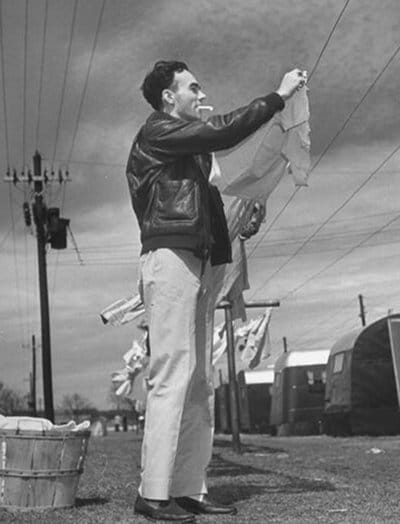
Not everything goes in the dryer. Remember: read the label. Some garments will say things like "Lay flat to dry." In that case, spread it out flat on a towel, smoothing out the wrinkles. If it doesn't go in the dryer, but doesn't need to be laid flat, you can drape it over a drying rack or a chair. Even if a garment can technically go in the dryer, if you don't want it to shrink -- perhaps it was just the right size when you bought it or the freshman fifteen is making your jeans feel tight -- go ahead and put it on the drying rack instead of the dryer. And of course, if you're living in a house or apartment that allows line-drying, that's a great option too: no shrinkage, less wear and tear on your clothes, no energy or quarter use, and that fresh air smell.
Clean out the lint screen. Before you put your wet clothes in the dryer, check the lint screen. A clean lint screen ensures that damp air leaves the machine and your clothes get dry. You may have to clean out the screen in the middle of a large load filled with items prone to shedding fuzzy stuff, i.e., towels, denim, etc. Oh, and make sure to save that lint! It's a fantastic fire-starter.
Place clothing in dryer a few pieces at a time. Clothes tend to get lumped and knotted together in the wash. Throwing your wet clothes into the dryer in a giant ball will result in some clothes getting super dry and others remaining damp. To avoid this, grab a few items at a time from the washing machine, shake 'em out if they're tangled up, and then place them in the dryer.
Don't cram the dryer. Just as you don't want to cram all your clothes into a single wash cycle, you won't want to cram all your clothes into a single drying cycle. Clothes need space in the dryer to tumble and get completely dry. You'll save yourself time and money in the long run by breaking up your drying into smaller loads.
Throw in a fabric softener sheet. To avoid static cling and to give your clothes that soft, comforting feeling, throw in a fabric softener sheet. For smaller loads, you can use just half a sheet.
Select the correct drying temperature. Rule of thumb when it comes to drying temperatures: the hotter the drying temperature, the greater the likelihood of shrinking. If the care label on your garment says "Tumble Dry," you can use the "regular" temp setting on your dryer. Regular is the hottest temperature and is suitable for sturdy cottons like towels, t-shirts, underwear, jeans, and sheets.
The medium setting is suitable for permanent press clothing -- synthetics and fabrics treated with wrinkle-free chems.
Low is for stuff like knits and lingerie. Again, if you're a man, you'll likely have very little clothing that requires this setting.
Remove dried clothes immediately. To avoid wrinkles, remove your dry clothes from the dryer and fold and iron them immediately (we'll be covering these skills later in the month). The longer you let them sit there, the more the wrinkles set.
Laundromat Protocol
Many young men reading this will likely be washing their clothes in public laundromats and dormitory basements. Washing your clothes in shared machines requires pluck, craftiness, and social grace that you don't need when washing your clothes in the privacy of your home. Below we provide some fast and not so hard rules to help you navigate the often strange world of laundromats:
Go on off days and off times. "Saturday or Sunday is probably a good day to wash clothes. I've got nothing else going on." You know what? That's what everybody else in your dorm/apartment is thinking too. I remember attempting my first wash in the college dorm on a Saturday morning only to find it jam-packed. Tuesdays or Wednesdays are good days to go to the laundromat. If your schedule permits, go in the afternoon. If not, become an early-riser and do your laundry first thing in the morning.
Grab plenty of quarters before leaving. Yes, some laundromats and dormitory facilities use credit card or student ID readers these days, but it's a good way to put your change to use, and the change machines at laundromats that lack credit card machines are often broken.
Check washers and dryers before putting your clothes in. A leftover blue sock can turn your whitey-tighties into baby blue under-roos. Also, make sure to clean out the lint screen, but use a paper towel. You don't want to touch the discarded pubes of complete strangers.
Use multiple machines when you can. One of the benefits of going to the laundromat on off days is that you'll likely have access to multiple machines. So instead of washing and drying one load at a time, you can have multiple loads going at once, thus cutting your laundry time down significantly. Of course, you need to be courteous when using this technique. Don't be the guy who hogs three machines when there's a line of other people waiting for an open machine.
Be wary about leaving your laundry unattended. People steal laundry. Take that into consideration before leaving your laundry unattended. I know you'd probably prefer to be other places besides a laundromat, but I'd recommend hanging around until your clothes are finished. Get some work done while you're waiting or read a book. Make use of that downtime. If you do decide to leave your laundry washing/drying unattended, be sure to set a timer on your phone so you come back right when the cycle is done; don't make someone else take out your laundry and pile it on a table so they can use the machine.
Don't forget your manners. Ask people to move their own laundry if you need space on the tables; nobody likes a strange man handling their intimates. On the same note, don't take up too much space. You don't need to sprawl all your clean clothes out on the table to fold them.



